SCOP versus Pounds and Pence
In this article; SCOP versus Pounds and Pence, I will try to demystify the relationship between heat pump COP/SCOP and the amount you would pay for your heating and hot water.
It may sound stupidly obvious, but alongside COP/SCOP (the performance of the heat pump), the amount you pay for your electricity also has a bearing on things too.
There will be some calculations explained below where you can calculate your own gas versus heat pump running costs.
Let’s crack on.
What is COP and SCOP?
The metrics used to determine how well a heat pump installation is performing are known as COP (coefficient of performance) and SCOP (seasonal coefficient of performance).
Both of these can also be used as a simple benchmark to compare performance between individual heat pump installations.
- COP is a point in time snapshot of performance. Like for an hour, a day or week for example.
- SCOP on the other hand is the performance across the whole year (or heating season). Sometimes also referred to as SPF (seasonal performance factor).
So you would likely work out your SCOP on a rolling 365 days starting from your installation date or the start of January to the end of December.
COP or SCOP is simply the relationship between the energy put into the heat pump and the heat it has outputted.
So a simple example would be
- Electric in: 1 kWh
- Heat Output: 3.5 kWh
The COP calculation would be (heat output 3.5kWh ÷ electric in 1kWh), so a COP of 3.5 (or 350% efficient)
The main factor in the changing performance of your heat pump is fluctuations in outside temperature.
You can clearly see in this diagram that the performance of the heat pump changes with outside temperature.
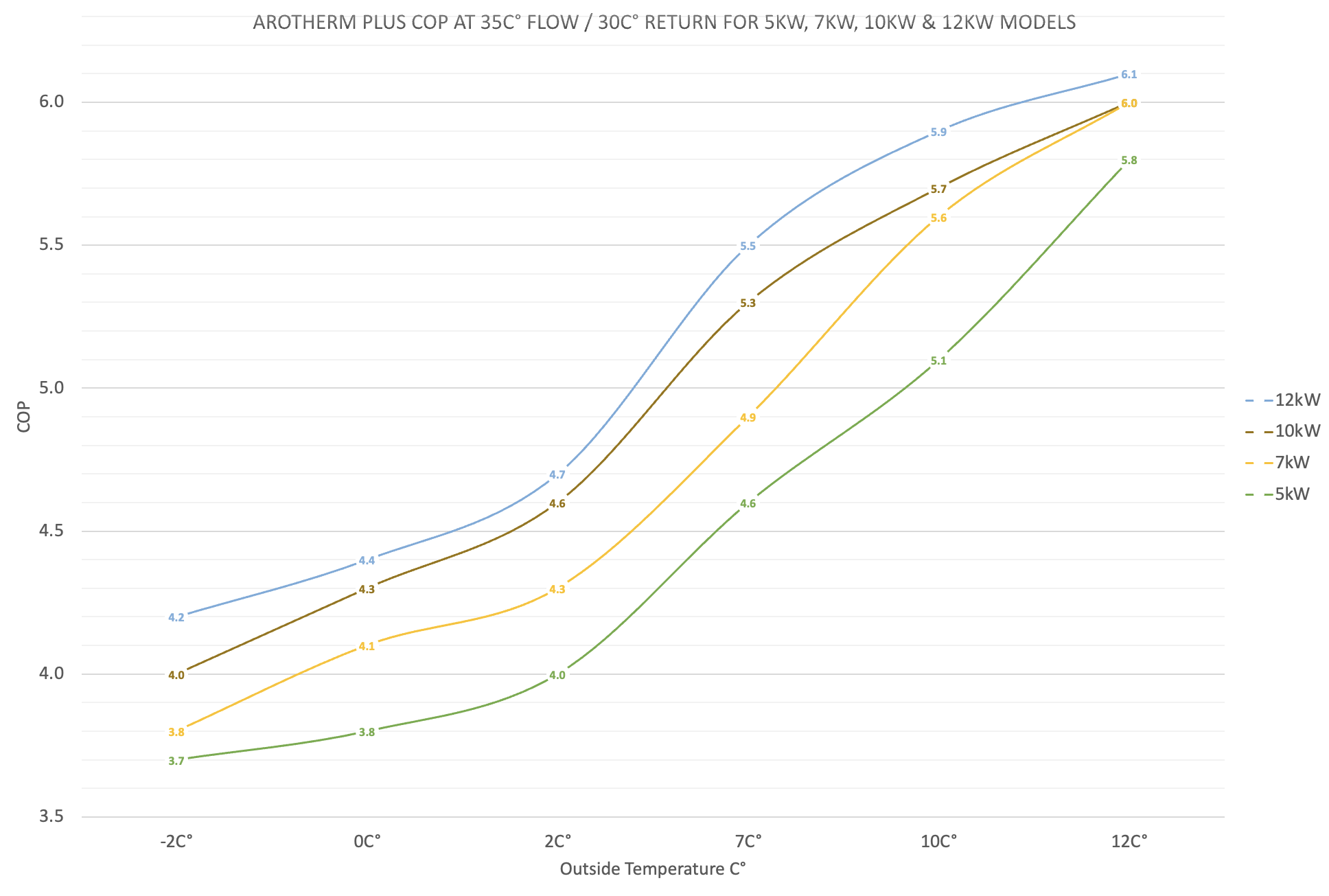
This diagram shows expected COP with 35 C° flow and 30 C° return temperatures at various outside temperatures for different sized Vaillant Arotherm models.
You can see how performance rises sharply at 2 C° outside and higher.
COP can change hour per hour and day by day, so it makes sense that we use SCOP to show overall trends. SCOP is the average of all the individual COP data points.
You can see over on https://heatpumpmonitor.org/ how a variety of different make, model and sizes of installation are performing with their SCOP listed.
https://heatpumpmonitor.org/ is an independent monitoring platform that uses data from heat meters attached to heat pumps along with open source hardware/software from Open Energy Monitor to monitor and chart performance over time.
Does a gas boiler have a COP metric?
In a way, yes!
Combi boilers work best when the return temperature of the water in the heating system comes back to the boiler lower than 55C as you can see on this diagram. Marked as the ‘dew point’.
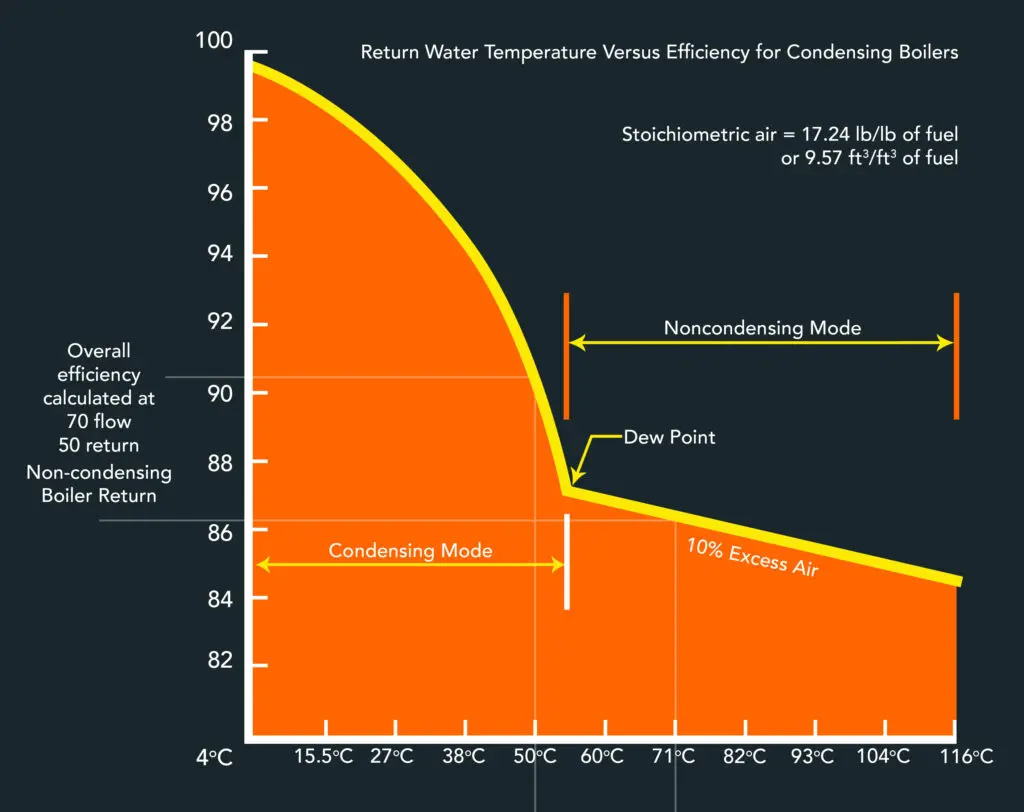
This diagram shows that if a boiler runs with 55C return temperature it is around 85% efficient. If you can lower that return temperature below 50C you may get to around 90% efficiency.
An 85% efficient gas boiler means
- Gas in: 1 kWh
- Heat Output: 0.85 kWh
If you compare those combi boiler efficiencies, 85% to 95%, to a heat pump at 350%, you can instantly see the heat pump magic in action.
For the purposes of this article I am going to use a consistent 85% when relating to gas boiler efficiency as we’d hope most people would be hitting this.
If you think your boiler installation is performing better as you are running it at a lower temperature, please adjust any calculations accordingly.
Note: I wrote an article on Low Temperature Heating a number of years ago when running my combi boiler at low temp.
Low Temperature Heating
Gas Price versus Electricity Price – the elephant in the room
As of October 2023, here are the average UK gas and electricity per kWh unit prices on Octopus Energy flexible tariff:
- Gas: 6.89p
- Electricity: 27.35p
Source: https://octopus.energy/blog/energy-price-cap-oct-2023/
If you divide 27.35p by 6.89p the ratio is 3.98
The disparity between gas and electric unit prices is bonkers. I have written about the various issues and reasons behind this later in the article.
Daily standing charges are also lopsided:
- Electricity: 51.32p
- Gas: 27.47p
But in all likelihood the pricing of the standing charges is a moot point because if you have a gas boiler you also need electricity for it to run, so you’ll almost certainly already be paying both.
By making the switch from gas boiler to heat pump there is the opportunity to have your gas supply capped and gas meter removed.
With that you would no longer have to pay the gas standing charge which could save you £100.26 per year (27.47p x 365 days)
You can find more details about how to do that via the Octopus website.
How to compare what a heat pump could cost using your gas usage
Let’s take a single day where your house needs to buy 50 kWh of gas for both heating and hot water.
That gas would cost you 50 kWh x 6.89p per unit = £3.45 using October 2023 prices.
Because your gas boiler is likely only 85% efficient we first need to make that calculation.
50 kWh x 0.85 = 42.5 kWh of energy used (7.5 kWh of energy lost by the heating process in the boiler), hence only 85% efficient.
So we’ve determined the house needs 42.5 kWh of heat on this day. How much electricity would we need to buy to generate that amount of heat using a heat pump?
Well this is where the magic of a heat pump comes in.
If we take a 350% efficient heat pump (COP/SCOP of 3.5), we’d make the following calculation:
42.5 kWh ÷ 3.5 COP = 12.14 kWh
So to generate the 42.5 kWh of heat we need, we’d only need to buy 12.14 kWh of electricity using a 350% efficient heat pump.
That 12.14 kWh electricity, at 27.35p per unit would cost £3.32 using October 2023 prices.
Day costs
- Gas: £3.45
- Electricity: £3.32
Making the gas/electric COP calculation across the whole year
You can easily make that same calculation across the whole year. Take the amount of gas kWh you have used across the whole year from your annual utility bill.
If you used 11,800 kWh of gas across the whole year (at a cost of £813 at 6.89p per unit), you’d make the following calculation.
(11,800 kWh x 0.85) = 10,030 kWh of heat required ÷ 3.5 COP = 2,866 kWh of electricity required on a 3.5 COP heat pump.
This 2,866 kWh of electricity would have cost £785 (at 27.35p per unit)
Whole year costs
- Gas: £813
- Electricity: £785
Minus £100 per year from the electricity amount if you can cap the gas off and lose the gas daily standing charge?
Why COP / SCOP matters
The above calculations show why a higher COP/SCOP is beneficial. You get more heat out for the same amount of electricity you put in.
Let’s look at this another way with a table.
We’ve got a variety of heat sources down the left hand side of the table
- Gas Boiler at 85% efficiency
- Heat pump at 280% efficiency (the bare minimum allowed under the current boiler upgrade scheme)
- Heat pump at 350% efficiency
- Heat pump at 400% efficiency
- Heat pump at 450% efficiency
And also a variety of fuel prices (per unit kWh) across the top headings
- Gas at 6.89p (October 2023 price cap)
- Electricity at 10p (perhaps you’ve got big batteries, a solar install, a Time of Use tariff and a Ripple investment)
- Electricity at 15p (Perhaps you just have solar)
- Electricity at 20p (Maybe just a Time of use or smart tariff)
- Electricity at 27.35p (October 2023 price cap)
The prices listed within the table show where the two elements meet.
Ie, a 350% efficient heat pump and electricity at 20p would cost £631 per year to run.
| Efficiency | Annual SCOP | Fuel Bought (kWh) | Heat Output (kWh) | Gas (6.89p) | Electric (10p) | Electric (15p) | Electric (20p) | Electric (27.35p) |
| 85% Gas Boiler | 0.85 | 13000 | 11050 | £896 | n/a | n/a | n/a | n/a |
| 280% Heat Pump | 2.8 | 3946 | 11050 | n/a | £395 | £592 | £789 | £1,079 |
| 350% Heat Pump | 3.5 | 3157 | 11050 | n/a | £316 | £474 | £631 | £863 |
| 400% Heat Pump | 4.0 | 2763 | 11050 | n/a | £276 | £414 | £553 | £756 |
| 450% Heat Pump | 4.5 | 2456 | 11050 | n/a | £246 | £368 | £491 | £672 |
Note: 11,050 kWh of heat is the amount I needed to keep my 1930 semi detached house to 20C inside and heat our 250L water cylinder across the whole of last year.
Our house is 90 sqm with a measured heat loss at 4.1 kW per hour when -3C outside.
More details about my property here:
If your house is bigger (or smaller), just adjust the table in line with your own fuel bought / heat output.
A recap on the daily calculation:
- (Gas Bought x Boiler efficiency) / SCOP = electricity required
- (11,800 kWh x 0.85) / 3.5 = 2,866 kWh
And the yearly calculation:
- Annual Gas Bought x unit rate = gas cost (11,800 kWh x 6.89p = £813)
- Electricity required x unit rate = electricity cost (2,866 kWh x 27.39p = £785)
As you can see from the chart, the only way you’d pay more than gas with a heat pump is if it was a pretty terrible install and got just 2.8 SCOP, and at the same time you were paying the maximum price for your electricity.
In every other scenario the running costs of a heat pump would be less than gas.
How can you reduce your electricity costs
With the likes of Cosy heat pump tariff, tracker tariff, a solar installation, batteries or a time of use tariff like Agile it is possible to pay much less than 27.3p per unit, and as such, lower your yearly heat pump running costs.
With solar for example, you’d likely get close to 6 months free hot water in the summer, running the heat pump off sunshine as well as significant contributions to heating in the shoulder months.
Octopus Tracker tariff averaged 19p per unit from January 2023 to November 2023 with Agile tariff around the same 20p mark.
Batteries allow you to purchase off peak (cheaper/greener) electricity to use at other times. But note, your electricity usage will rise considerably with a heat pump so your batteries may empty themselves more quickly each day than they do without a heat pump. But they will still be useful nonetheless.
So there are plenty of accessible ways to reduce your average electricity unit cost.
I couldn’t possibly list all the combinations to reduce the unit rate of electricity, but hopefully you get the idea of what is possible. Some of it is very straightforward.
A heat pump and a solar installation with batteries are the renewable holy trinity.
Time of use tariffs are then the cherry on the top.
But don’t ignore SCOP!
But don’t ignore SCOP, especially if you can’t drastically reduce your electricity cost.
SCOP becomes the most important thing if you have higher electricity costs as you can see from the chart.
At the 27.35p unit rate of electricity, a 450% efficient heat pump would cost 40% less to run than a 280% efficient one.
If you can, obviously aim for the best SCOP possible AND also reduce your electricity costs. This is the killer combination.
How is my personal system doing?
Recall that I have solar, batteries, an EV, time of use tariffs and also have an investment in Ripple.
- Over last winter my average import price was 14p
- My solar generated over 4100 kWh across the whole year
- And my Ripple investment also reduced my overall bill
Most of my renewal items have their own blog post:
So you could easily say I’m down in the 10p Electricity range.
In the first 365 days since installation, my heat pump has recorded a SCOP of 3.6, so 360% efficient for both heating and hot water.
Buying 3086 kWh of electricity to generate 11,109 kWh of heat.
The split is around 4.2 SCOP on heating and 3.2 SCOP on hot water.
My hope is that I will see an increase in SCOP in the second year after making a few system tweaks.
But in summary, 10p electricity and 3.6 SCOP puts me on the better end of the table from the earlier section. My running costs are almost one-third cheaper than my previous gas boiler.
You can view day to day performance of my heat pump over on my Open Energy Monitor page:
Is a 450% SCOP heat pump really possible?
As of November 2023 there are only a small number of heat pumps with a whole year of data recorded so far.
Note: mine is highlighted in red on the chart below.
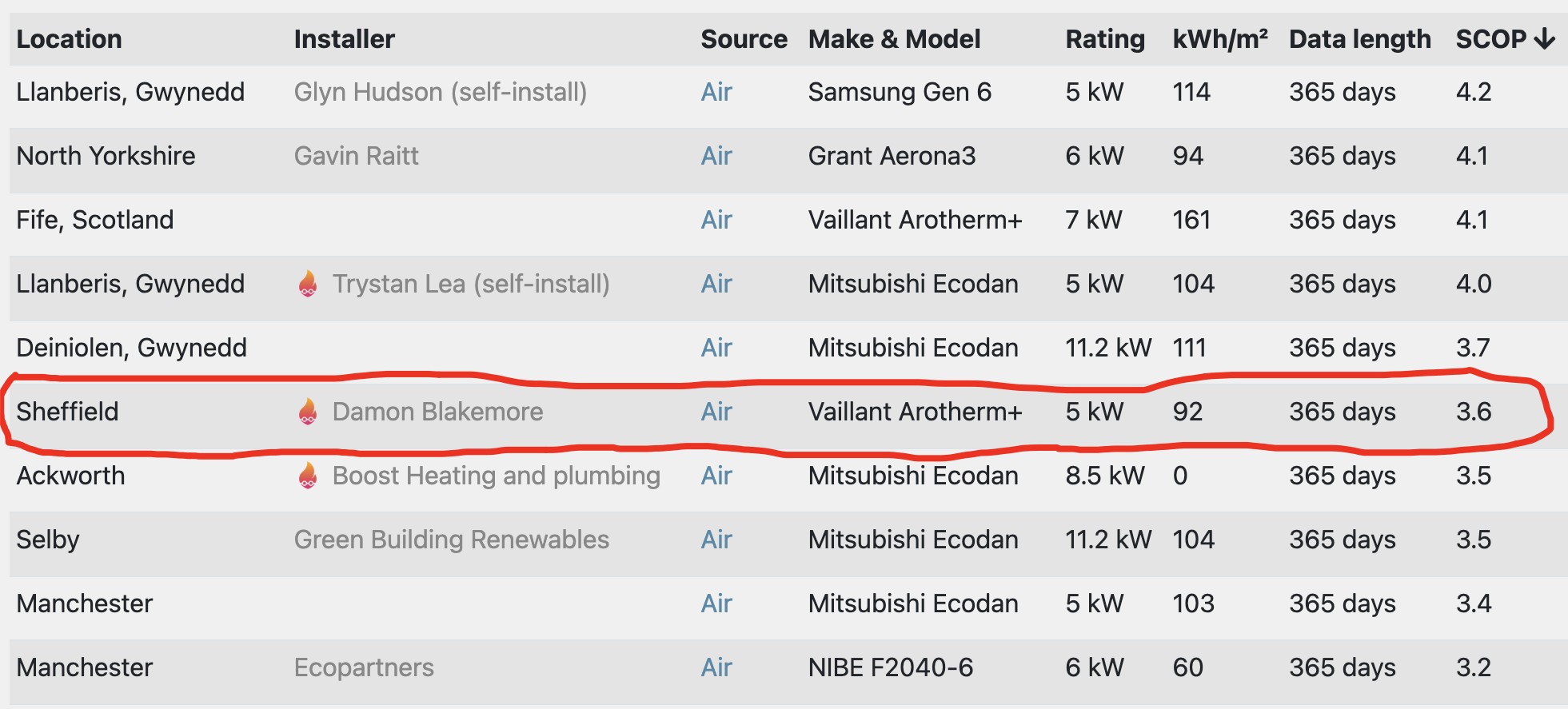
This shows the top 10 from the systems with a whole year of data.
The highest showing a SCOP of 4.2, the lowest a SCOP of 3.3 and an average SCOP of 3.75 across all 10 systems listed.
But things are changing, and for the better.
With more installers undertaking Heat Geek training, the knowledge about how to install high performing heat pump systems is spreading and growing.
There are already new entries on the https://heatpumpmonitor.org/ chart pushing monthly COP past 5 right now. You can confidently suggest these will be in the mid to high 4 SCOP at the end of their first full year.
The Future of Electricity Pricing
No one has a crystal ball, but you would hope that electricity pricing would reduce over the coming years, or at least the disparity between gas and electric could narrow?
There are a number of levies applied to electricity that are not applied to gas. Perhaps a policy change in the future could swing this in the favour of electricity?
As the amount of renewables continues to grow we should hopefully see prices come down. We should definitely see more occurrences when there’s an abundance of renewables and with that, reduced pricing periods. Just like we have seen on the Agile tariff over the last few years.
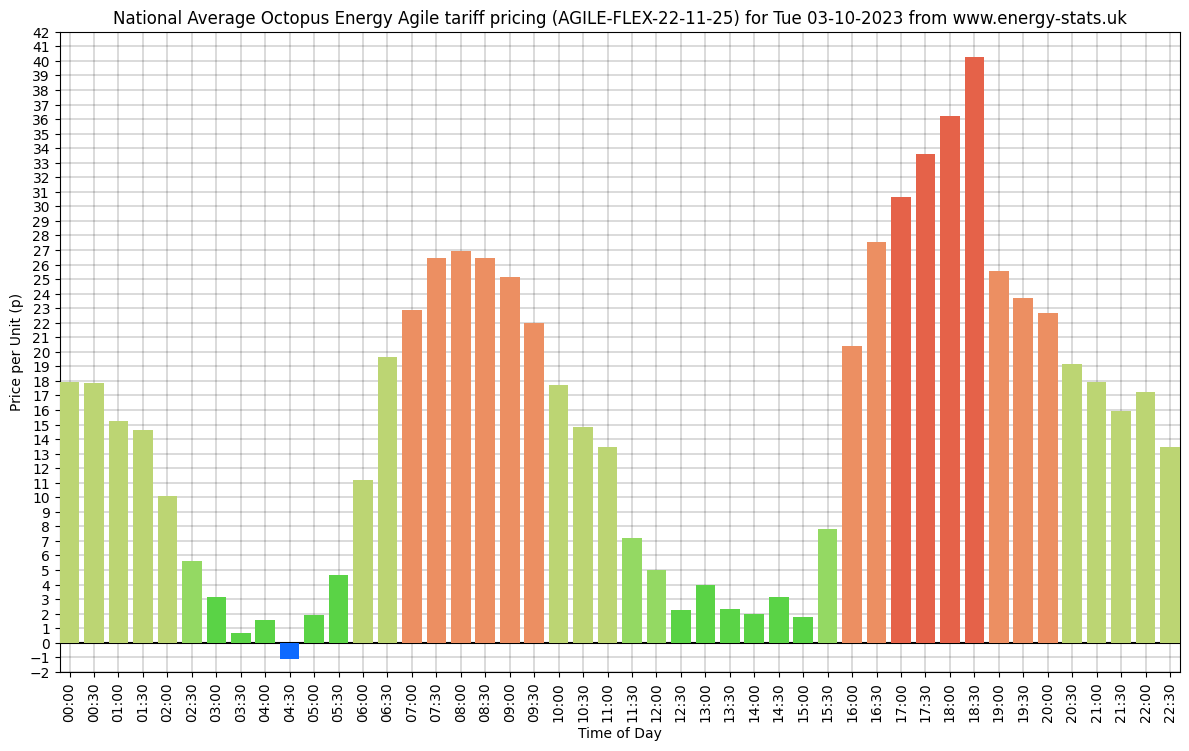
With the building of the Dogger Bank windfarm out in the North Sea the scale of renewables coming is bananas.
Using Robin Hawkes amazing interactive renewables map you can see the potential this wind farm has. Just look at the size of that large circle in the North Sea compared to the current wind farms.
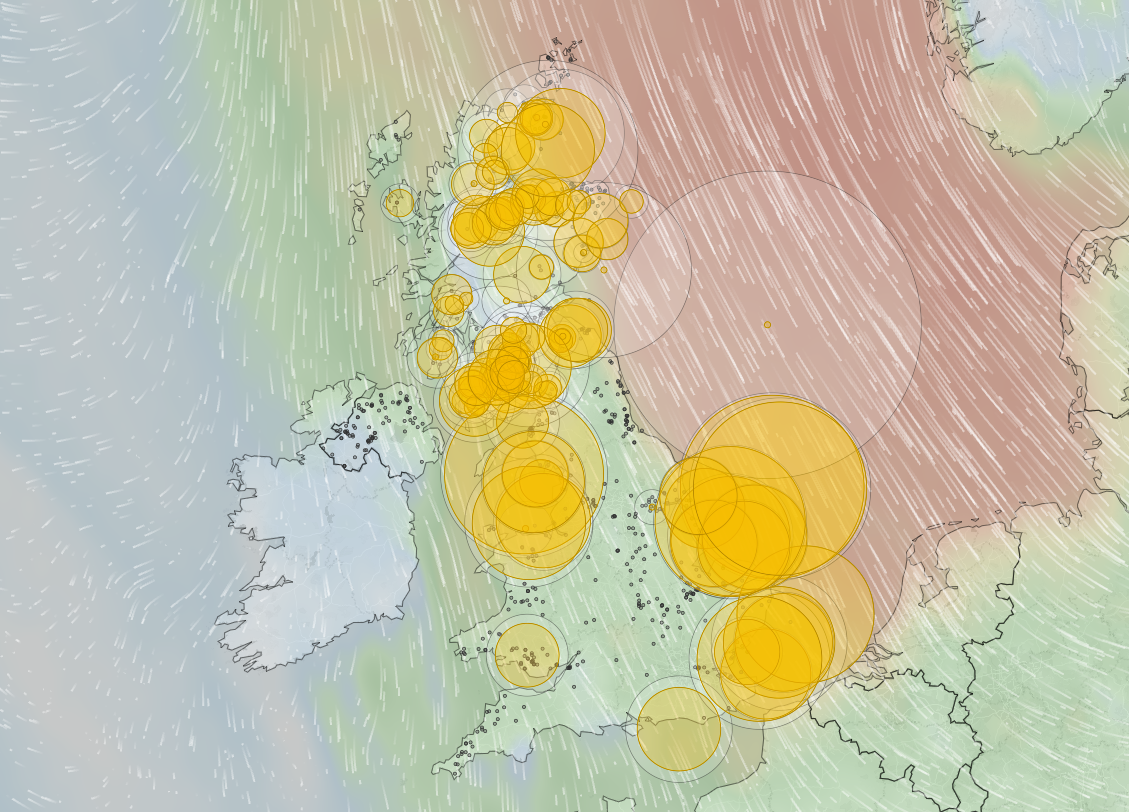
The final hurdle is that wholesale price of electricity is currently intrinsically linked to the most expensive source (usually price of gas) each day by a process known as marginal pricing. Again, hopefully policy changes can unlink these things, especially the renewable elements.
Summary and Round Up
As it stands, the wide disparity between gas prices and electricity make the running costs of a heat pump a hard sell.
But as shown above, it doesn’t take much to make a heat pump cheaper to run than a gas boiler.
Choose a different tariff or invest in some renewables and you’ll be well on your way.
Ensure your installation performs the very best it can to get the best SCOP possible. Discuss your requirements / targets with your installer.
And whilst the article has primarily focused on money, any heat pump replacing a gas boiler is a fantastic thing for the environment. It’s not always about the money.
Fingers crossed the government continues to push the electrification of heat and addresses the issues affecting electricity prices.
If you can couple electricity pricing with a highly efficient installation then running a heat pump becomes a bit of a no brainer.
Referral information and free credit offer
If you find Energy Stats UK useful, there are a couple of easy ways to support the site and help cover hosting and server costs.
Thinking about switching energy suppliers?
Homeowners who join Octopus Energy using my referral link get £50 free credit after signing up. Business users get £100 free credit, and if you’re looking at solar or a heat pump, there’s also a £100 gift card through Octopus Tech.
Or, if you just want to say thanks, you can buy me a coffee.
You can also see more ways to support the site here via the likes of Plusnet broadband, Smarty Mobile, Havenwise remote heat pump control, Hetzner Cloud hosting and more.
Follow @energystatsuk on Twitter / X, Bluesky and Mastodon for daily tariff graphs and updates.
Note: The current and past performance of energy pricing is not necessarily a guide to the future.





One Comment